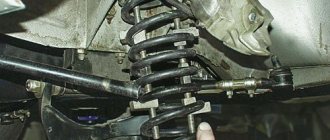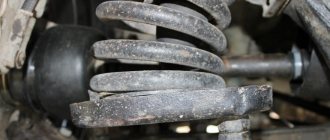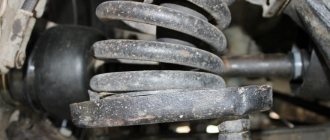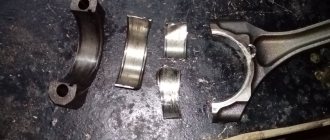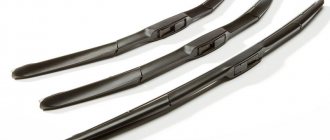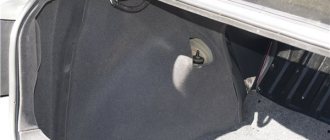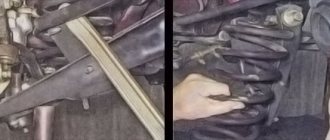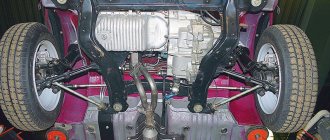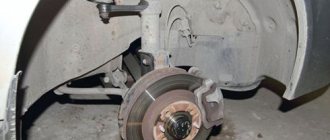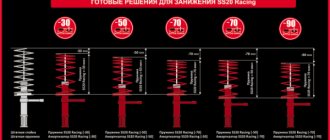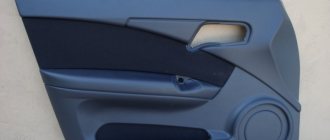Suspension parts on Russian roads very often experience heavy loads - any collision with a stone or falling into even a small hole becomes a real test for them. And they do not always pass through it without losses in the form of mechanical damage. This is especially true for shock absorbers and springs, which work together and often fail due to constant shaking. And if installing new struts is a prerequisite when repairing a car’s chassis, then whether it is necessary to change the springs when replacing shock absorbers is a difficult question for many drivers. To answer this, you must first understand the function they perform.
Function of shock absorbers and springs
These parts provide the car with improved handling along with a smooth ride. Moreover, springs are part of the suspension, which neutralize shocks and impacts when driving on poor-quality road surfaces. In fact, such an elastic element during its operation makes millions of compression-release cycles. In addition, if the car hits an obstacle, the wheel jumps up and the vehicle becomes uncontrollable. And in order to stabilize the situation as quickly as possible, the spring bounces back, simultaneously compressing so that the wheel falls to the ground as quickly as possible. However, after this part has been released, the vehicle continues to sway for a long time due to the released energy. The shock absorber, which has a rather complex design, is designed to quickly dampen these vibrations.
The modern automobile industry has long mastered the production of reliable springs of varying stiffness, so such parts rarely fail. But the racks are not as durable - they periodically need to be replaced. However, you need to understand that the answer to the question of whether it is necessary to change the springs along with shock absorbers depends on another important factor. After all, the suspension will only work well when these parts interact correctly with each other. For example, dampers hold the weight of the car, and struts control their movement, and if one of the elements of this combination does not work at full strength, then the other will have to take on an increased load. And if the springs sag due to metal fatigue or cracks in them, then the shock absorbers will fail much faster.
If you do not practice an aggressive driving style, the elastic elements of the suspension are able to fully perform their work even when coasting even at 300,000 km. The stand is considered the weak part in this combination, since depending on the type it contains a special gas or liquid. In addition, its design includes many sealing rings, which, under increased loads, lose their ability to ensure tightness.
Springs: purpose, replacement
The washing machine tank spring is located in pairs with the same spring at the top of the washing machine body. This complex holds the tank and returns it to its original position.
The return spring has two ends, each with a hook. On one side, the spring is attached with a hook to the SMA body, the other hook holds the tank. Spring breakage usually occurs near the fastening. To remove the spring, it is not necessary to follow a strict sequence - you can disconnect it first from the body, and then from the tank, or vice versa - it does not matter.
Before replacing the spring, you need to decide how you will remove the faulty part.
You can remove it through the place where it is attached to the tank. To do this you need:
You can also remove the spring through the top of the machine:
- The first two stages are similar to those listed above.
- Holding the spring with your hand, pry up the fastening hook with a thin screwdriver.
- Unhook the spring from the housing.
- Move it to the side and unhook it from below.
Attention! If some parts bother you, you will have to remove them.
We are often asked how to replace a spring. If you follow science and hope that the machine will work longer, it is better to replace the spring with an original part.
We wish you successful repairs. Successfully replace your springs, dampers or shock absorbers and your car will run as quietly as when you bought it.
Sooner or later, you and I change the shock absorbers on our iron horses, some call them struts. Our roads, to put it mildly, are far from ideal, and therefore after 60 - 80,000 they begin to tap or simply leak - these are signs that indicate that replacement is needed. BUT MacPherson technology implies a prefabricated structure in which a spring is already inserted, but the new strut comes without it! And here a fair question arises - do you need to change the spring or can you leave the old one? We'll figure out …
It must be remembered that the springs are located both at the front and at the rear of the car, but still, structurally, these are different tasks, although they perform the same job.
However, first, a definition.
Springs (for use in cars)
- this is an elastic suspension element, which is designed to make our ride comfortable and safe, by softening the shock received by the suspension from the road. Also, this element does not allow the wheel to come off the road surface during strong impacts (for example, hitting a high bump); it tries to return the wheel to the road, thereby making handling much better.
Causes and consequences of spring failure
Springs can lose their damping properties due to many factors. For example, if you heavily and regularly overload a car, then they will sag. Also, these parts may no longer fully perform their function due to the following reasons:
corrosion of metal;
mechanical wear;
driving on uneven road surfaces or roads full of rocks and other obstacles;
metal fatigue.
If the spring has lost at least part of its properties, the car holds much worse on the road and does not listen well to the steering wheel. The braking performance of the vehicle also decreases, and the shock absorbers wear out ahead of schedule.
By strength
As you understand, these two elements work, as they say, “side by side.” But they have different indicators in terms of strength and wear.
Spring
– a very durable element, if you don’t break it on purpose (don’t overload the car), don’t “drive the car recklessly” when entering 90-degree turns at maximum speed, don’t fly into curbs – then it can last a very long time, there were cases when it took 200 – 300,000 kilometers.
Shock absorber
- this is the weaker part of the suspension, the whole point is that it is much more complex in structure, it has a bunch of o-rings, there is liquid or gas inside. And damage to one of the elements entails failure of the entire structure. And with our roads and potholes, you can kill him for several thousand (50 - 60). This is not Europe, where they travel 150–200 thousand kilometers.
Accordingly, we change shock absorbers much more often than springs.
When do springs need to be changed?
Whether the springs need to be changed when replacing shock absorbers depends on their condition. However, many auto mechanics argue: it is better not to save money and install a new assembly on the car, and to refuse reckless driving, which significantly reduces the service life of the suspension elements. However, ultimately, much depends on the circumstances of the repair - for example, struts in some cars can only be installed as an assembly with a spring - and the decision of the car owner himself. At the same time, there is a lot of visual evidence that the dampers definitely need to be replaced:
the height of the car has changed: to determine this, it is enough to compare the distance of all wheels to the wheel arches;
there are defects in the spring coils;
initial corrosion of the dampers indicates that it is better to replace them;
the inability of the spring to unbend to the required height after a compression cycle.
The only thing that cannot be noticed during a visual inspection of these parts is metal fatigue. Therefore, when repairing the suspension, it is still recommended not to install springs with traces of rust on new shock absorbers, otherwise sooner or later these parts will need to be replaced again.
So do you need to change when changing shock absorbers?
To be honest, the question is twofold. And it is not always possible to say in the affirmative. Let's look at two situations:
1) The suspension has covered 30,000 kilometers, but after the winter the strut began to leak and needs to be replaced. In this case, the mileage is really small, you just need to change the strut itself and the rest of the elements can be left, by the way, this also applies to the support bearing. Metal fatigue will be at a low level, and corrosion will not yet make large changes to the parameters. There is only one condition - you need to install an original or the same rack.
2) Mileage is about 80 - 100,000 kilometers. I will say this - with an average motorist driving 20,000 per year, such a mileage is approximately equal to 4 years, in small towns it can be 5 - 6 years. What am I getting at, even if you only drove on smooth roads, then the winter road (which means salt, sand and many other delights) definitely has a bad effect on the metal that makes up the springs. YES, and with such a mileage, metal fatigue is already significant. Therefore, if your shock absorber “dies,” in this case you need to replace it completely with the spring.
I’ll list them point by point again, for those who are “squeezing for money”:
From sand, reagents, stones, etc. – the metal wears off and suffers, which reduces strength.
Tired of time, 80 – 100,000 is a serious mileage.
Subsidence. The spring may decrease in size, albeit not significantly, but this will be enough for a new shock absorber; its service life will decrease.
Therefore, with such long runs, we definitely change it.
Is it possible to swap springs?
It would not be amiss to mention the frequent practice of many car owners: in an effort to save money, they swap the springs, that is, the dampers on the driver’s side are installed on the front passenger’s side. This is usually done if passengers are rarely transported. Moreover, such work is often carried out independently.
This method, of course, has a right to life, but it cannot be called reasonable and professional. After all, the spring on the driver's side is subject to heavy loads, and moving it to the right side of the car only temporarily solves the problem. In fact, the owner of the vehicle himself creates a weak point in it, because it has already been proven many times: like shock absorbers, springs need to be replaced only in pairs per axle. Ignoring this rule leads to an imbalance in the suspension - after all, the left and right springs have different operational properties. And this in many cases leads to a deterioration in the car’s controllability, as well as a decrease in ride comfort - after all, the dampers absorb impacts from the road surface much worse. Therefore, when repairing the suspension, you should always remember that an attempt to save a certain amount can lead to a significant decrease in the safety of the vehicle.
What else should you not do?
However, many of our “VAZ DRIVERS” don’t care at all; I’m already silent about the lowered Priors. When repairing suspension, and in particular replacing struts, many people prefer not to change other elements, even with high mileage.
I personally witnessed when a guy took the KYB struts, came to the service station, and said, “we leave the springs and support bearings (after a mileage of about 80,000).” Simply - HARD! Guys, turn on your brain. Companies do not always have interchangeable parts, even new ones! That is, you cannot take a KYB strut and install a spring from a VAZ supplier, this is no longer correct, and you are installing a new shock absorber on worn parts!
In the best case, the rack will fail in 10 - 15,000, and then this GUY will shout at every intersection that “I installed KYB, such a g..but!”
In the worst case, there is a possibility that it will fly off the road, because the sagging, tired, corroded “coils” will not be able to properly hold the car and dampen the amplitude of body vibrations. Which negatively affects maximum speeds, cornering, and braking. The body will pull more to the sides during maneuvers.
Therefore, the moral is not to save money, we buy a completely new set.
Rear suspension
Here the situation is almost the same. Although the suspension design is radically different. Here the shock absorber is not inserted directly into the spring, but comes as if separately. That is, if it is “covered”, it is much easier to replace it! Just unscrew two bolts and remove it, then install a new one.
If you don't haul heavy loads and your vehicle is front-wheel drive (all the weight is in the front), then the rear end will suffer much less. I know from experience that there will be a replacement in 150 - 200 thousand, and maybe more. However, it is advisable to change everything at once.
How to check a suspension spring
To check the condition of the car suspension spring, it must first be removed from its seat and cleaned of dirt and rust. This will allow you to visually assess its condition, check for cracks, chips and other defects.
First of all, you need to check the spring for stiffness. However, before that you need to find out what class it belongs to, as well as which springs the car manufacturer recommends installing on the part of the suspension from which it was removed.
All springs are divided into two main classes - A and B. Their differences are in stiffness and length. The length of A-springs is up to 27.8 cm, and the length of B-springs is over 27.8 cm. As for color coding, this depends on the specific car brand and spring manufacturer.
Press check
To determine the fatigue of springs using the compression method, you need to know what stiffness it should be installed in a specified location in order to know with what to compare the result obtained in the future. So, in garage conditions, spring stiffness can be checked using the following tools:
The verification algorithm in this case will be as follows:
If the spring has compressed a certain distance with insufficient force, this indicates that it has weakened significantly and it is advisable to replace it. However, the decision to replace must also be made on the basis of a visual inspection, as well as information about how many kilometers the car has traveled with a given spring.
However, in practice, this method is quite problematic to implement, since the test requires considerable effort. For example, when testing the springs of a VAZ-2110 car, you need to develop forces equal to 325 kilograms of force. With this value, standard front suspension springs must have a length of at least 201 mm (for the so-called “European” spring, the same value will be 182 mm). For a rear standard spring with the same force, its length will be at least 233 mm (for a “European” spring - at least 223 mm).
Theoretical calculations
The permissible geometric change of the spring, as well as its stiffness, can also be calculated using the appropriate formulas. Thus, the geometric change is calculated as follows: X = F × L / C. Here X is the change in spring size, F is the applied force, L is the initial length of the spring, C is the proportionality coefficient, table value (depends on the radius of the coil part of the spring, material its manufacture, rod diameter).
Similarly, the stiffness of the spring is calculated using another formula - k = F / X. Here, too, F is the force, and X is the size of the compressed spring measured as a result of experiment. The complexity of such calculations is due to the fact that you need to know the proportionality coefficient, and this information can only be found in technical documentation.
Checking the manual
The technical documentation (manual) for any car contains a detailed description of the procedure for checking ground clearance, and, in particular, springs. Let's consider a similar diagnosis using the example of the popular Toyota Camry. So, for this you first need to measure four parameters:
Functional purpose of springs and shock absorbers
Structurally, the functioning of springs without shock absorber struts is impossible, so both parts complement each other, and the breakdown of one of them affects the performance of the other. That is why car owners often doubt whether it is worth replacing these two parts as a set.
Working in tandem, the strut and spring take on the entire weight of the car when overcoming any obstacle in the form of uneven surfaces. This makes it possible to remove the load from the suspension and protect it from damage, especially when the car gets into deep holes when driving off-road.
The spring is made of high-strength material that has sufficient elasticity to soften the shocks of the car body while driving. This part has a spiral shape with several turns. When moving through pits, it compresses or straightens, ensuring the wheel returns to a stable position. When the wheel hits the road surface, the pressure forces the weight of the body downward.
To soften this pressure and protect the moving components, shock absorbers with springs are used. In this tandem, the shock absorber strut helps to quickly stabilize the vibration of the spring during the amplitude swing of the body.
